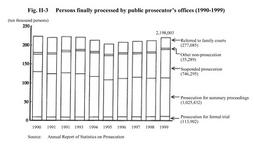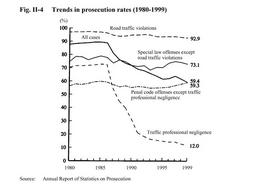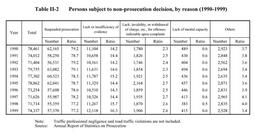| Previous Next Index Image Index Year Selection | |
|
|
Fig. II-3 shows trends in the number of persons finally processed by public prosecutor's offices over the last 10 years (see Appendix II-1 ).
The component ratios for each processing category in 1999 were 5.2% for prosecution for formal trial, 46.7% for prosecution for summary proceedings, 34.0% for suspended prosecution, 1.6% for other cases of non-prosecution, and 12.6% for referral to family courts. The prosecution rate was 59.3% (a decrease of 2.6 points from the previous year)and the prosecution suspension rate was 39.6% (an increase of 2.6 points) (see Appendix II-3 ). Figs. II-4 and II-5 shows trends in the prosecution rate and the prosecution suspension rate in the 20 years since 1980. Fig. II-3 Persons finally processed by public prosecutor's offices (1990-1999) Since 1987, the prosecution rate for traffic professional negligence has fallen(see Part 4, Chapter 3, Section 2 ). For penal code offenses excluding traffic professional negligence, however, the prosecution rate has generally remained between around 50% and 60% and the prosecution suspension rate between around 30% and 40% (see Appendix II-3 ).Fig. II-4 Trends in prosecution rates(1980-1999) Fig. II-5 Trends in prosecution suspension rates (1980-1999) Table II-2 shows the number of persons subject to non-prosecution decisions(excluding traffic professional negligence and road traffic violations)over the last 10 years, by reason for non-prosecution. Of the total, 415 persons (0.6%) were not prosecuted on grounds of lack of mental capacity, an increase of 32 (8.4%) from the previous year.Table II-2 Persons subject to non-prosecution decision, by reason (1990-1999) |



